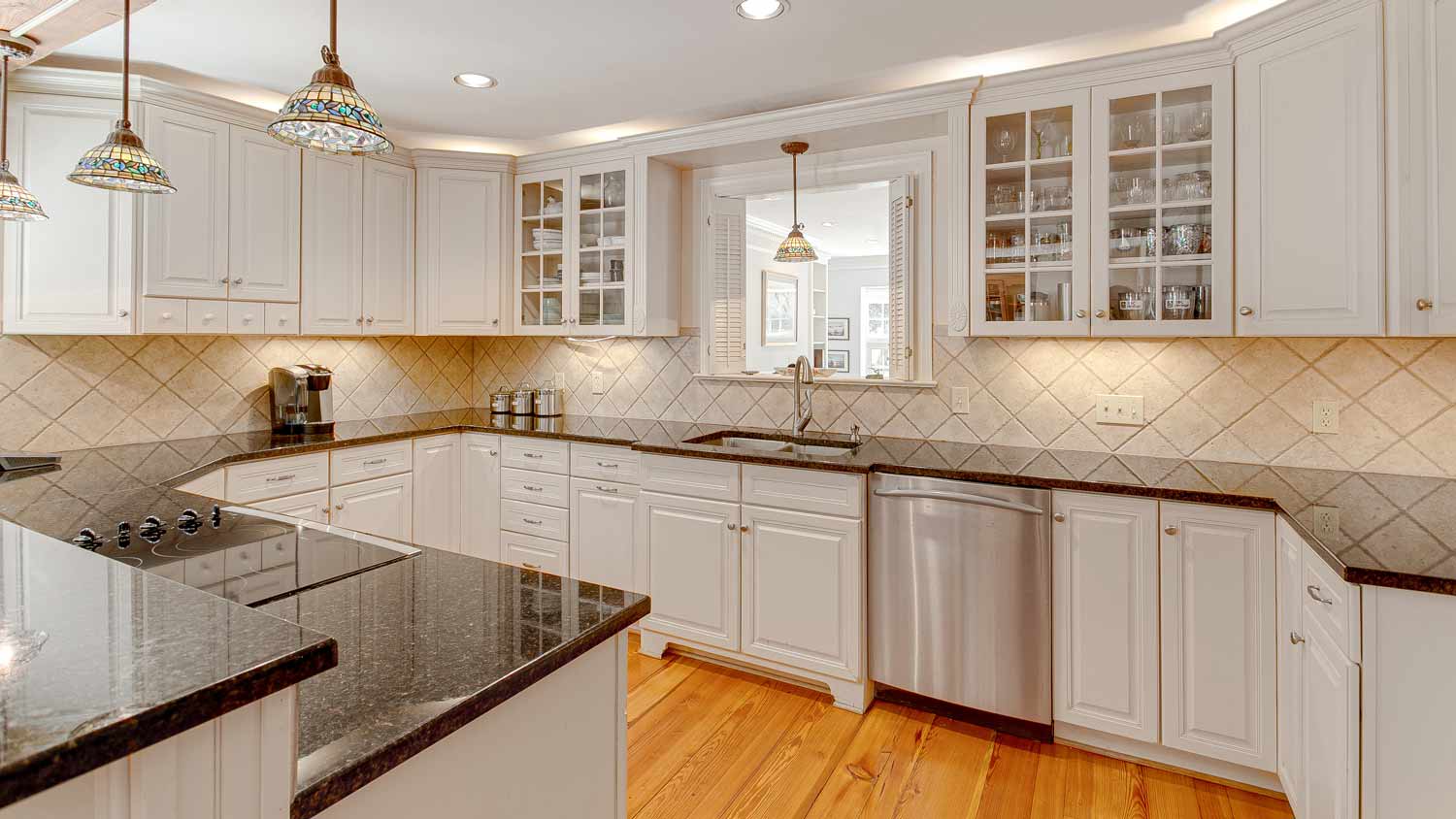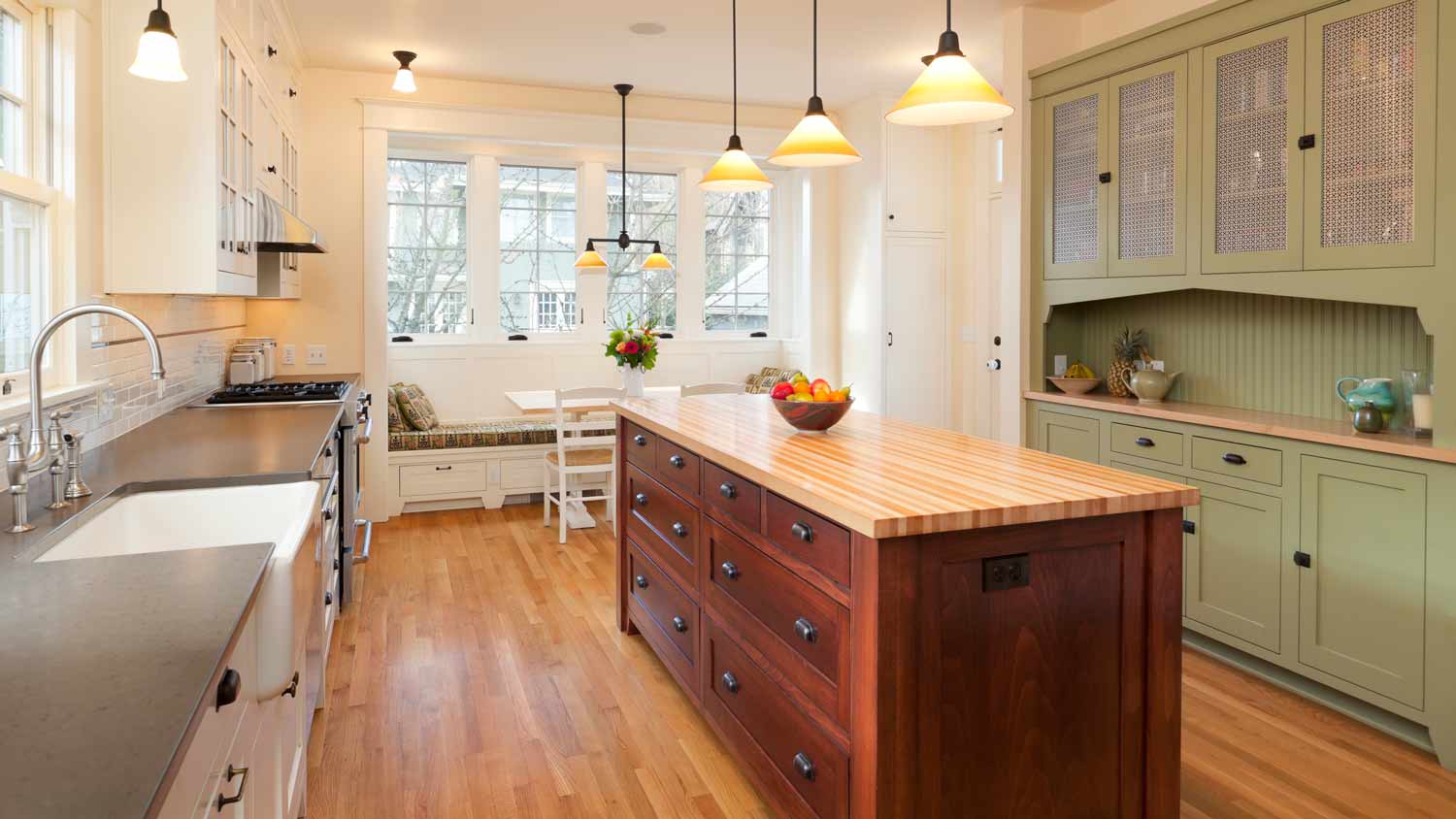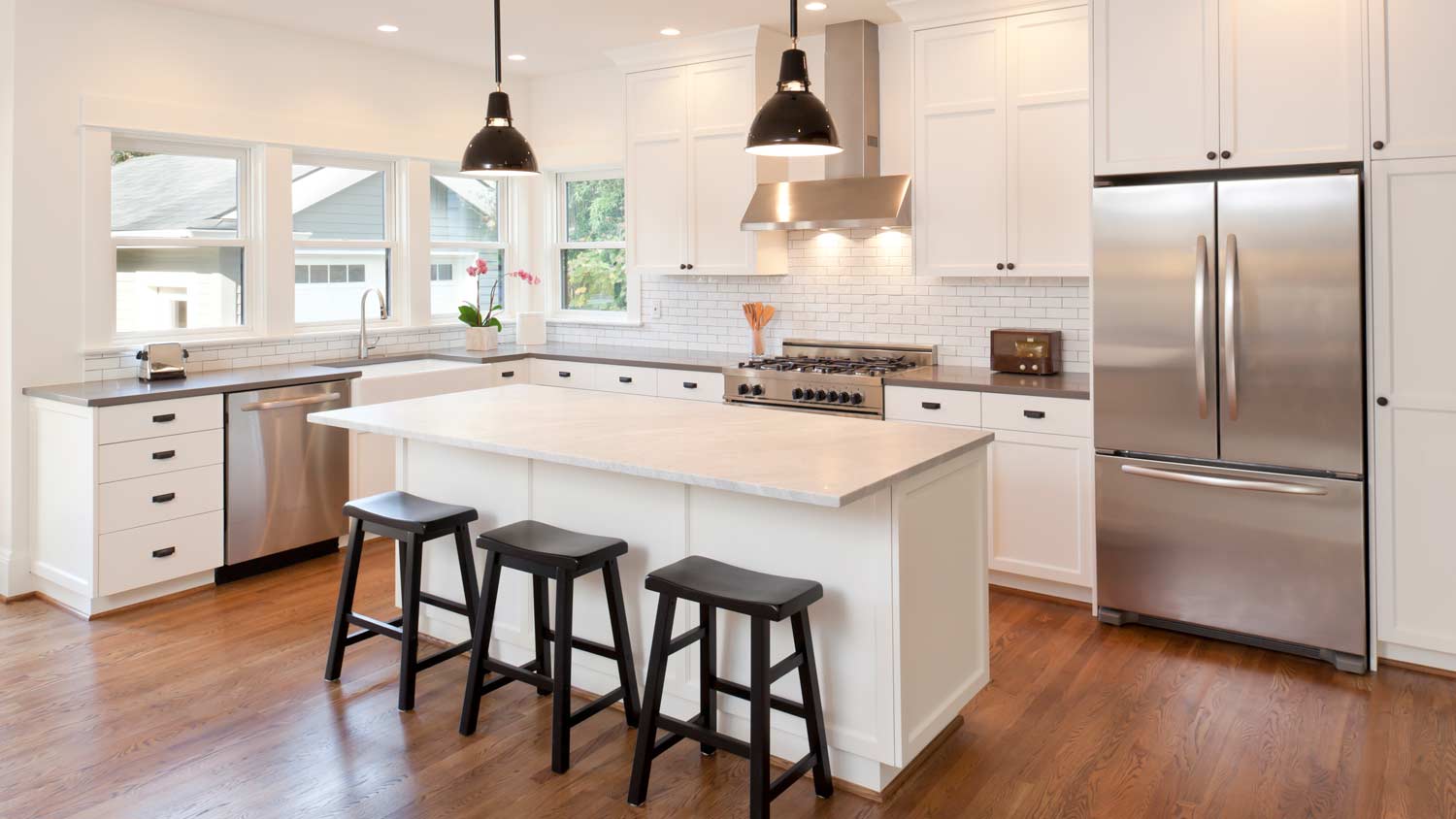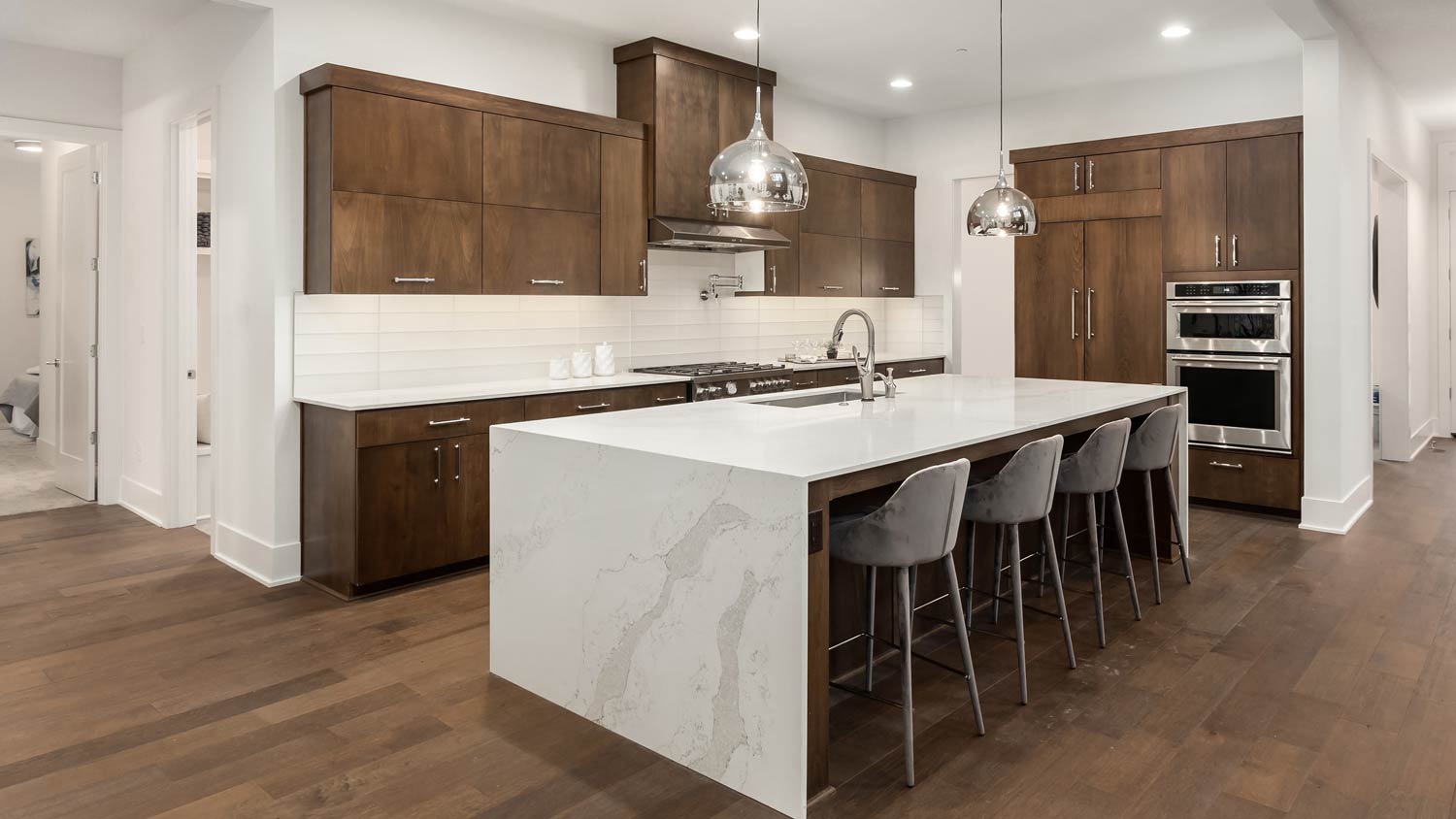
Countertop repair costs may be the deciding factor between replacing or repairing your counter. Let’s break down the cost to repair, resurface, or relaminate.
Sleek designs to storage galore—these kitchen islands can work in a variety of spaces


You’ve probably seen a home renovation TV show in which a closed-off kitchen transforms into a massive room with a kitchen island that could seat a small soccer team. And while large islands are great, there are many types of kitchen islands to choose from.
Kitchen islands, in fact, come in all shapes and sizes to accommodate rooms with a small footprint to open concept homes with space to spare. From islands on wheels to circular options, the types of kitchen islands listed below can help you learn more about each and decide which would work best for your home and budget.
| Type of Island | Biggest Benefit |
|---|---|
| Galley Island | Budget-friendly |
| Two-Tiered Island | Versatile use cases |
| L-Shaped Island | Lots of work space |
| U-Shaped Island | Has tons of seating |
| Circular Island | Prime gathering area |
| Full Function Island | Works as a central hub |
| Cart Island | Nice for tiny spaces |
| Furniture Island | Unique design option |
| Floating Island | Eye-catching design |
| Waterfall Island | Contemporary design |

Simple and streamlined, a galley-style island is best for—you guessed it—a galley-style kitchen. Galley islands typically run perpendicular to a wall of cabinets with a sink, oven, and cooktop, so the island itself is used to seat people, store any extra items, and serve food for larger groups. This type of kitchen island is also a more budget-friendly option since it falls on the lower end of the spectrum in terms of kitchen island costs, which typically range from $3,000 to $5,000.
| Pros | Cons |
|---|---|
| Good value | Common design |
| Simple design | Can seem boring |
| Fits most kitchens | Tends to be smaller |
Best for: Those who want an inexpensive design option

Also referred to as a bi-level island, a two-tiered island features two separate spaces: one for cooking or preparing and the other for seating or eating. The cooking/prepping portion is shorter than the seating/eating side, which is raised, so it’s ideal for bar seating.
If your kitchen is more traditional or farmhouse style, a bi-level island will fit right in. However, if you lean toward a more streamlined, modern style, you may want to consider single-level island options with sleek countertop materials.
| Pros | Cons |
|---|---|
| One level for prep | Not a modern style |
| One level for eating | Tougher to clean |
| Highly versatile | Upper items may fall |
Best for: Those who need both food prep and eating space in one

A popular style for a slightly roomier kitchen is the L-shaped island, with two separate work surface areas. The L-shaped island is perfect if you want a multi-functional design that offers a space for food prep, a dedicated seating area, and ample storage opportunities to tidy away your clutter. If you have multiple cooks in the family, there’s no need to jockey for space.
However, it’s not suitable for small, narrow kitchens, you need a decent-sized space to accommodate this style. If you have an open-plan kitchen or love clean lines, this island shape can interrupt the room’s flow. It's also more challenging to work across the entire kitchen space efficiently. The many angles and corners also break up valuable storage space.
| Pros | Cons |
|---|---|
| Extra working space | Creates tough angles |
| Tons of storage | Needs a big kitchen |
| Multi-functional | Odd-shaped cabinets |
Best for: Those who have large kitchen spaces

If you have a large kitchen, and if you want to have a lot of permanent seating, the U-shaped kitchen island brings multiple benefits for you. Some designers use the back side of the island to make bench seats, adding a kitchen table in the middle of the U shape. You also can use the U-shaped island to create specific types of food prep areas in different parts of the kitchen. This design offers a lot of counter space, so you can easily make the space your own. If you have a one-wall kitchen design, this island can give you significant benefits.
| Pros | Cons |
|---|---|
| Large seating area | Needs a huge kitchen |
| Separate prep areas | Can be pricey |
| Allows bench seats | More corner cabinets |
Best for: Those who want lots of seating or clearly separate prep areas

Although they’re not as common in newer homes, circular islands still hold a rightful place in the kitchen island conversation. They can be round, oval, or circular, providing plenty of space for friends or family to stand around while you pour drinks or get dinner ready. Some circular models even have enough space for a sink, so that you have extra countertop space on the surrounding sides of the kitchen. The only downside to this type of kitchen island is that it can be more expensive since it is not as in demand and can be hard to find or make.
| Pros | Cons |
|---|---|
| Unique design | More expensive |
| Can include a sink | Harder to source |
| Gathering space | Tough for seating |
Best for: Those who want an island that encourages gathering from friends and family

It has a sink, a dishwasher, maybe even a refrigerator drawer or wine fridge—in short, a fully functional island has multiple appliances that allow it to be a central hub in your kitchen. Most fully functional islands have enough counter space to provide room to prepare or serve food, which is why this type of island is an excellent option if you entertain frequently or have a large family.
If you're replacing appliances during your kitchen remodel, you can call a local junk removal company to take the old ones off your hands. Some appliance companies will also offer removal services if you buy a new model. Never try to dissemble your old appliances and dispose of them yourself, because they may contain dangerous materials.
But a fully functional island is not a low-budget item; in fact, it will be a more high-end build or installation due to the plumbing and electrical work required for its many features. It’s worth it, however, if you have a spacious kitchen that’s open to your living area, a fully functional island can make your space the perfect place for gathering.
| Pros | Cons |
|---|---|
| Has everything you need | Expensive |
| Highly versatile | Complex installation |
| Ideal for gathering | Needs large kitchen |
Best for: Those who want electrical power and plumbing in the island

Ideal for small spaces, a mobile island usually comes on wheels so that you can roll it into the kitchen when you need to chop veggies or prep for dinner and wheel it back out when it’s time for people to fill up their plates. Some mobile islands are made with butcher block countertops for easy prepwork, and others have wheels that can be locked into place to take up a semi-permanent residence in galley, U-, or L-shaped kitchens. This type of island is also a great option for renters who can’t make permanent changes to their home but want the convenience of an island on wheels.
| Pros | Cons |
|---|---|
| Fits small kitchens | Limited prep space |
| Inexpensive | No power or plumbing |
| Ideal for renters | No permanent install |
Best for: Those who have extremely small kitchens

Perhaps you found an antique piece that you love and want to incorporate somewhere in your home. With the furniture-style type of kitchen island, you can convert this item into an island.
Certainly, some risks exist in trying to convert another piece of furniture into a kitchen island. Can it handle the stress of daily kitchen use? Will it support the weight of a countertop? How will food and liquid spills affect it? But a local kitchen remodeler often can convert the item safely for you. A skilled local carpenter could even create a one-of-a-kind piece for you for this specific use case.
| Pros | Cons |
|---|---|
| Unique designs | Sturdiness concerns |
| Can be custom built | Hard to add plumbing |
| Use almost anything | Not ideal for seats |
Best for: Those who want unique design options

No, floating kitchen islands don’t actually defy gravity, but they give that appearance. While there are several iterations of this island type, it typically refers to the version that hides the pedestal portion of the feature where the base meets the floor—making it look like it’s hanging in mid-air. These trendy islands have great functionality and sleek, modern style, but they don’t work well in small kitchens and are more expensive to build than other types like galley or L-shaped islands.
| Pros | Cons |
|---|---|
| Trendy, modern style | Pricier than average |
| Hidden pedestal | Not for tiny kitchens |
| Plenty of storage | Can be difficult to construct |
Best for: Those who want a sleek, modern style

When you want your island to take your guests’ breath away, the waterfall design has a look that no other type of kitchen island can duplicate. For a waterfall island, your local countertop installer will extend the counter material over the edges of the island, continuing to the floor. It looks like the countertop material spills over the island like a waterfall.
This design delivers elegance and a high-end feel that’s sure to impress, no matter what kind of countertop material you want to use. It is an expensive design, and it can limit some of your seating options. However, it’s easy to clean, as it protects the base of the island from spills and splashes in the kitchen.
| Pros | Cons |
|---|---|
| Unique and beautiful | Expensive |
| Contemporary design | Tough to add outlets |
| Easy to clean | No seating on ends |
Best for: Those who want a high-end, contemporary island design
Your kitchen can be as unique as your needs, so selecting the right kitchen island is equally important. The factors below can help you determine which type of kitchen island is best for your space and lifestyle.
The size of your kitchen has a major influence on which type of island you can install. A galley kitchen or other small kitchen layout likely isn’t conducive to a round island, for instance, since space can be limited. On the other hand, open-concept kitchens are much more flexible. If you have enough square footage, a fully functional island is great for large families who can use the extra seating and counter space for everything from doing homework to grabbing a bite of breakfast before school or serving a buffet-style meal. Ultimately, the best kitchen island size should not be more than 10% of the total square footage of your kitchen.
What purpose do you want your kitchen island to serve? The answer will help you narrow down kitchen island types to figure out what suits your needs. If you love to host friends and family for game nights, brunches, or sporting events, you likely want an island with enough space to serve and seat guests. In this instance, you may be looking at choosing a bi-level, galley, or fully functional island. Those who don’t spend as much time entertaining but love to cook can benefit from a mobile island, which provides more space to chop ingredients and can be moved out of sight once the meal is in the oven. The way you plan to use the island will play a role in determining the best kitchen island height as well.
If you’ve saved up enough funds to foot the bill for a kitchen island with the works, then you’re likely prepared for the cost of a fully functional kitchen island. However, if you want to be more conservative with your budget, a circular or mobile island might be the best fit. Those who fall in the middle and want something more permanent can pay extra for a bi-level or shelf and cabinet duo island, which still provide style, function, and room for a few barstools or extra storage. You may even want to consider the perfect finishing touch of adding a skylight over your kitchen island if your budget is large enough. If you want some help determining options within your budget, start by figuring out who builds kitchen islands in your local area, which can be a kitchen remodeler or a countertop installer. Reach out to a local countertop installation professional for an estimate.
Melissa Graham contributed to this piece.
From average costs to expert advice, get all the answers you need to get your job done.

Countertop repair costs may be the deciding factor between replacing or repairing your counter. Let’s break down the cost to repair, resurface, or relaminate.

If you’re looking to refinish your countertops, epoxy will make them shine for years to come. This guide will help you budget for epoxy countertop costs.

The cost of stainless steel countertops may seem shocking compared to laminate, but their durability may be worth it. Here’s how much you can expect to spend.

Comparing limestone versus granite countertops comes down to looks, price, and strength. Learn to spot the differences and what to expect from each in this guide.

Although cutting stone may seem difficult, it is possible with the right tools and knowledge. Learn how to cut granite for bathroom and kitchen counters.

The best types of countertops for your home offer a perfect balance of budget, maintenance, look, and durability. This guide breaks down popular choices.